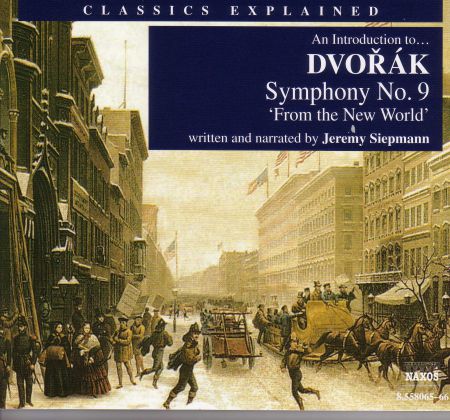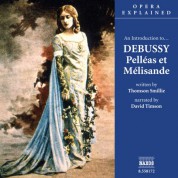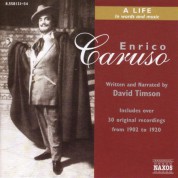
Classics Explained: Dvorak - Symphony No. 9, 'From the New World' - CD
Tükendi
Bu Ürün Stoklarımıza Girince Haberdar Olmak İster Misiniz?
(+) Stoklara Girince Haber Ver
(+) Stoklara Girince Haber Ver
Ürün Hakkında
Barkod: 0636943806524
, Katalog No: 8.558065-66 , Firma: Naxos
, Seri: Naxos Classics Explained
, Yayınlanma Tarihi:
1 Temmuz 2002
Format Türü: CD, Format: 2 CD
Eser Listesi
- CD - 1
- An Introduction to … DVORAK Symphony No. 9, "From the New World" (1893)
- 1. A quiet beginning: sorrow, syncopation, and sequence
- 00:02:38

- 2. Instrumental colour as a prime element: clarinets and bassoons, an outburst by the French horn
- 00:00:57

- 3. The opening tune again, with different instrumental colouring: now flutes and oboes
- 00:00:32

- 4. The first big surprise: strings, shattering drumbeats, shrieks from flutes, oboes, and clarinets
- 00:00:37

- 5. Cellos and basses take us into a new key while flutes and oboes dance in syncopation.
- 00:00:32

- 6. Horns, violas, and cellos introduce a new idea, soon to evolve into the main theme.
- 00:00:31

- 7. A tiny detail from the opening culminates in a wild drumming that heralds A Major event
- 00:00:43

- 8. Introduction complete
- 00:02:05

- 9. A solo horn introduces the main theme, perkily answered by bassoons and horns.
- 00:00:39

- 10. The theme moves to G Major; answering phrase from flutes, oboes, bassoons.
- 00:00:33

- 11. Long crescendo, tremolo strings, back to tonic and biggest statement yet of the main theme.
- 00:00:39

- 12. Transition to the secondary theme through the use of sequence. Sonata form; satability and flux
- 00:01:36

- 13. Three-bar groupings and again the use of sequence, spelling out a chord
- 00:00:34

- 14. The sequence continues to rise, and the four-bar phrase returns as the standard unit.
- 00:00:18

- 15. The first violins start off the next phrase, but the melodic shape is more compact.
- 00:00:21

- 16. The violins fall silent; the violas and cellos answer with a new figure
- 00:00:09

- 17. So now we have a two-bar group, made up of statement and answer.
- 00:00:07

- 18. The same thing again (though not quite the same)
- 00:00:05

- 19. Transition complete. The secondary theme arrives, with French horns as 'bagpipes'.
- 00:01:00

- 20. The 'bagpipe drone' is taken over by cellos, with their insistently repeated G and D.
- 00:00:19

- 21. The tune is taken up by cellos and double-basses, 'shadowed' by the second violins.
- 00:00:57

- 22. The violins continue a pattern of steady pairs, and the cellos and basses introduce a new idea.
- 00:00:33

- 23. Unexpectedly, we find ourselves back with the secondary theme. A new idea emerges.
- 00:00:26

- 24. Again we hear the shortened version of the secondary theme
- 00:00:33

- 25. The suspense is heightened as everything slows down
- 00:00:25

- 26. This beautiful flute tune is said to resemble 'Swing Low, Sweet Chariot'.
- 00:00:47

- 27. A big crescendo leads to a final statement of the closing theme
- 00:01:16

- 28. The development section begins with a conversation between cellos, double-bases, and violins.
- 00:01:09

- 29. The beginning of the closing theme is taken up in turn by the horn, piccolo, and trumpet.
- 00:00:18

- 30. Sequential chirping from the oboes based on the 'answering' part of the main theme, now in thE Major
- 00:00:18

- 31. Much of the development comes from a diminution of the closing theme from the exposition.
- 00:00:19

- 32. A tiny detail becomes A Major ingredient, giving an agitated quality to an originally sunny tune.
- 00:00:31

- 33. Through a sequence of keys so quickly that it is hard to keep track of them
- 00:00:37

- 34. The main theme from massed cellos and double-basses, topped by two trumpets over tremolo violas
- 00:01:46

- 35. After that major climax, we arrive at the threshold of the recapitulation
- 00:01:04

- 36. Dvorak flouts tradition by setting the secondary theme and the closing theme in unexpected keys.
- 00:01:10

- 37. The tumultuous convulsion of the coda brings the first movement to its epic close.
- 00:03:09

- 38. Humpty Dumpty: putting the bits back together again
- 00:00:20

- 39. First movement (complete)
- 00:11:36

- 40. The very opening chords unmistakably herald the arrival of something special.
- 00:01:06

- 41. The role of instrumentation in setting the scene...
- 00:01:10

- 42. ...and in enhancing the quality of one of the most famous tunes in symphonic history.
- 00:01:29

- 43. The cor anglais is joined by the clarinet, creating a fascinating change in the timbre.
- 00:01:08

- 44. For the closing part of the tune, there is another new sonority: cor anglais plus bassoon.
- 00:00:24

- 45. The closing bar is repeated by clarinets and bassoons, the horn adding a new touch
- 00:00:28

- 46. Back to the start to hear the whole of the story so far, this time without commentary
- 00:02:24

- 47. A change of scoring: the slow opening chords return, this time played by the winds alone.
- 00:01:14

- 48. The changes in scoring are just beginning.
- 00:02:35

- 49. The flutes and oboes introduce a new tune, over hushed tremolo strings.
- 00:01:05

- 50. A memorable combination of continuous, asymmetrical melody with steady, march-like counterpoint.
- 00:01:28

- 51. Back in that woodland glade, the light and shadows have changed, revealing new shapes and patterns.
- 00:01:33

- 52. The next section is new and forward-looking, yet also a kind of dream-recollection of a past scene.
- 00:01:30

- 53. An abrupt change of mood, much discussion and embellishment, and a hushed note of expectancy
- 00:02:01

- 54. Subjectivity and expertise; Sourek and Tovey disagree; onwards, into the final section
- 00:05:14

- 55. Cue to whole movement
- 00:00:10

- 56. Second movement (complete)
- 00:12:00

- CD - 2
- An Introduction to … DVORAK Symphony No. 9, "From the New World" (1893)
- 1. Dvorak, Beethoven, and the Scherzo. Dvorak purposely confuses the listener's expectations.
- 00:01:54

- 2. Using a little fanfare, Dvorak further builds up expectation before revealing the main theme.
- 00:00:21

- 3. When the theme is revealed, we find that it is not exactly a tune.
- 00:00:36

- 4. Two little bursts of rhythm provide the seeds from which much of the movement grows.
- 00:00:24

- 5. It is the second half of the theme that dominates.
- 00:00:22

- 6. Back to the beginning to hear the whole of this opening section
- 00:00:48

- 7. Without ever being remotely 'academic' or 'intellectual', there is much counterpoint going on here.
- 00:00:20

- 8. Dvorak's very Czech love of combining conflicting rhythms, sometimes metres
- 00:02:31

- 9. A clearly transitional passage, obsessed with the rhythmic tag that both opens and closes the theme
- 00:00:30

- 10. Sooner than we may have expected, we seem to have arrived at the Trio section.
- 00:01:07

- 11. A new kind of tone quality sheds a subtly different light on the theme.
- 00:00:35

- 12. The flutes and oboes now chime in with an answering variant of the opening...
- 00:00:21

- 13. ...and the cellos and bassoons take up the original version of the theme.
- 00:00:43

- 14. A false alarm: it was not the traditional Trio section at all, but rather part 2 of Scherzo proper
- 00:00:52

- 15. Soon, after a very rapid build, the Scherzo proper does reach its final phase.
- 00:01:13

- 16. The orchestral texture thins dramatically, and we approach what this time really is the Trio section.
- 00:01:28

- 17. The Trio section is reminiscent more of the 'Old World' than the 'New'.
- 00:00:50

- 18. In the second half of the Trio, a new tune emerges, a kind of Slavonic waltz.
- 00:01:00

- 19. The main theme of the Trio returns against a much fuller orchestral background.
- 00:00:36

- 20. Then it is all a matter of repeats, until we reach the coda, which ends with an explosive bang.
- 00:01:15

- 21. Third movement (complete)
- 00:08:07

- 22. Like the first movement, the fourth begins not with its main theme but with an introduction.
- 00:00:47

- 23. The main theme: an imposing march, introduced by trumpets and trombones, with timpani
- 00:00:48

- 24. The main theme, part two. A codetta-like passage closes off the march
- 00:01:01

- 25. The 'transitional' theme, while outwardly contrasting, is actually a hidden variant of the march.
- 00:00:53

- 26. A point of future obsession
- 00:00:16

- 27. The second half of this 'transitional' theme is given to the winds the strings have finished.
- 00:00:16

- 28. The 'obsession' takes root, with a ten-fold repetition, before the arrival of the second subject.
- 00:00:57

- 29. The hidden traps in sonata-form terminology: 'second main theme' vx. 'second subject'
- 00:02:31

- 30. The unexpected entry and subsequent ubiquity of 'Three Blind Mice'
- 00:01:23

- 31. We meet the mice again, now in the cellos and double-basses, where they persistently refuse to run.
- 00:00:36

- 32. More 'Three Blind Mice' material
- 00:00:30

- 33. The mice return to the basement, where the bassoons have joined the cellos and double-basses.
- 00:00:19

- 34. Next, they are back with the clarinets who pass them back to the cellos
- 00:00:18

- 35. Now they return to the high winds, delicately trilling.
- 00:00:15

- 36. Relief, at last: the mice back off, making way for a remainder of the main theme from the trumpets.
- 00:00:34

- 37. The mice yield to woodpeckers; the main theme is now doubled in speed
- 00:01:07

- 38. The triplets of the 'transitional' theme are now handed down through strings
- 00:00:23

- 39. Reminders of past movements begin to fly by, thick and fast, sometimes very fast.
- 00:00:28

- 40. In fact there are three bits of quotation going on here simultaneously.
- 00:00:23

- 41. The violas react every time the 'Goin' Home' theme is quoted by the winds.
- 00:00:35

- 42. The rhythm of the opening of the 'Goin' Home' theme dominates, transformed by trumpets
- 00:00:35

- 43. The march theme reappears as a Mendelssohnian fairy; the main theme from the 1st mov. now returns.
- 00:01:55

- 44. We reach an interesting point: have we heard the beginning of the recapitulation, or not?
- 00:01:05

- 45. Perhaps this is it? Back for a reminder of the theme proper, as we first heard it
- 00:01:41

- 46. Tovey places the start of the recapitulation here.
- 00:01:27

- 47. The main theme recast in pathetic rather than heroic terms - and with magical scoring
- 00:01:51

- 48. This unexpected crisis in confidence plays A Major role in the overall dramatic impact of the mov.
- 00:01:49

- 49. The main theme returns - not complete, but chopped up into shorter and shorter fragments.
- 00:01:30

- 50. A glorious thematic stew; high drama, a powerful build-up... but then?
- 00:00:56

- 51. The dramatic highpoint of the mov., an astonishing transformation, but first, back to the original
- 00:01:26

- 52. The same chords again, this time blasted out by the entire wind and brass sections
- 00:01:09

- 53. Now we are into the finishing stretch, but the surprises continue to the very end of the very end.
- 00:01:42

- 54. Summary, context, and cue into the whole movement
- 00:01:05

- 55. Fourth movement (complete)
- 00:11:05

Katkıda Bulunanlar
|
|
Bu Ürünler İlginizi Çekebilir










